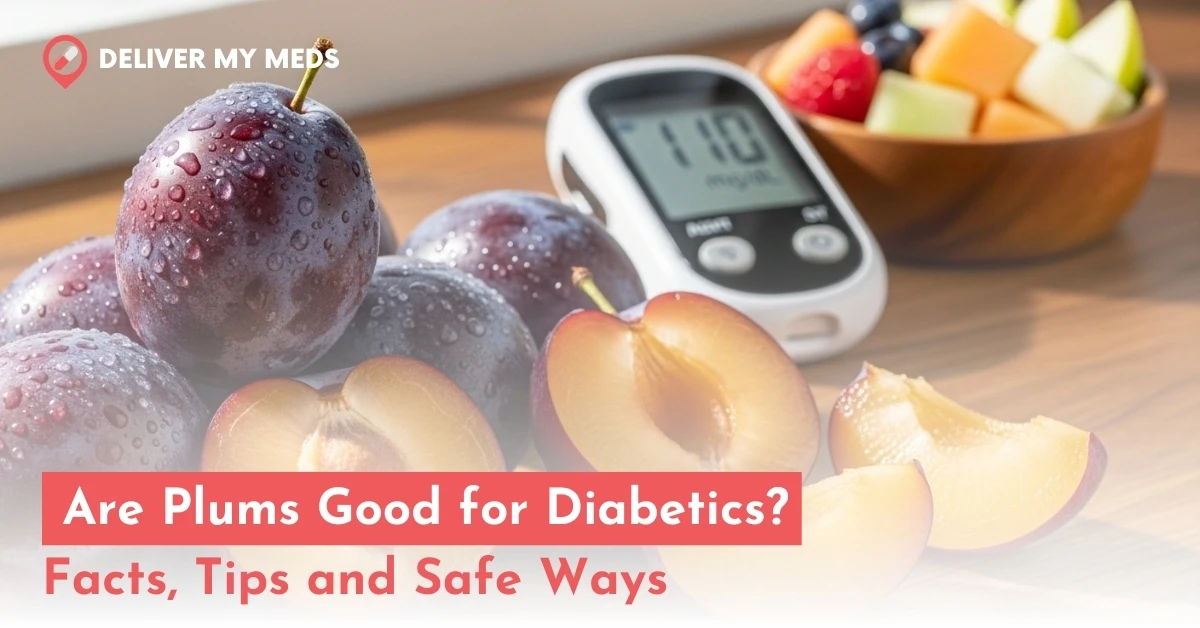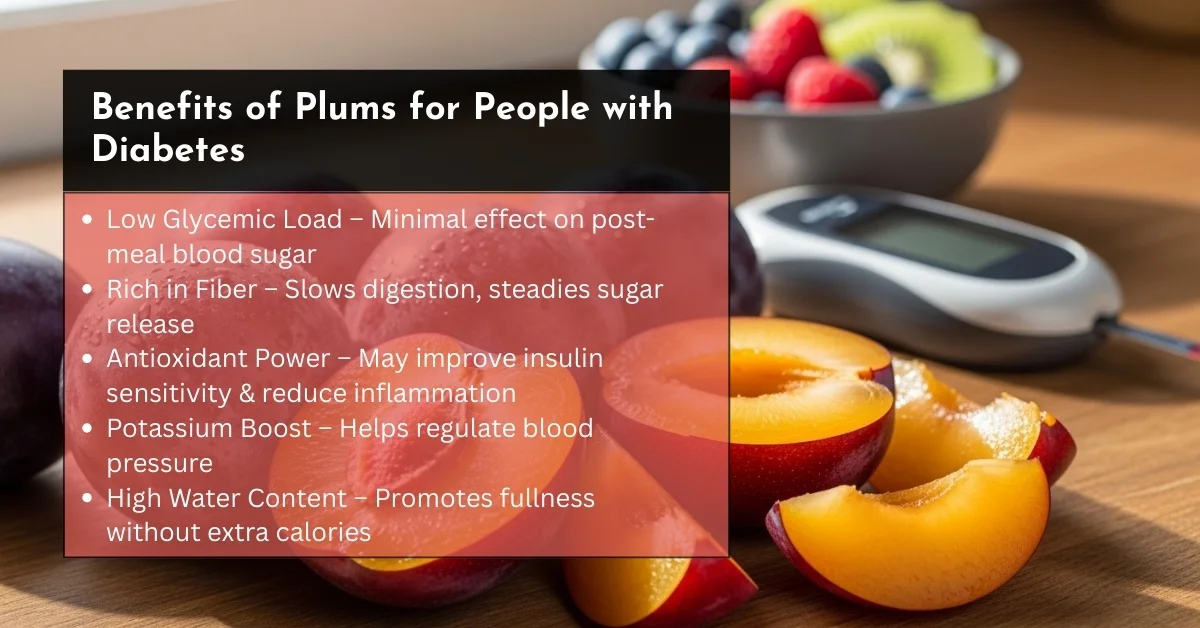
When you’re going to the grocery shop, you look at a stack of fresh plums. The plums look attractive, juicy, sweet and colorful. But then the question arises: Are plums good for diabetics? Will they support your health, or could they cause a blood sugar spike? If you’ve ever wondered this, you’re not alone. Many people with diabetes get mixed messages about plums and diabetes. Some sources suggest that plums are a smart choice in moderation, while others caution about their natural sugars.
In this blog, we’ll provide you with complete information, and together, we will find the solution. Like how plums actually affect blood sugar, how much is it safe to eat, and what to pair them with for better balance and clear the confusion.
At Deliver My Meds (DMM), we believe managing diabetes isn’t just about medication; it’s about making informed daily choices. And today, that choice is whether plums have a place on your plate.
Plums and Their Impact on Your Blood Sugar
Are plums okay for diabetics? The short answer is yes, thanks to their low sugar content and rich nutrients. If you bite a plum, the taste of the plum is juicy and sweet. Plums come in many varieties and colors, like black, red, yellow, and plum cherry, and they are also known as stone fruits. Plums are naturally sweet; if we compare them to other fruits like mangoes and bananas, they have less sugar. These are rich in fiber, vitamin C, vitamin K, and antioxidants that help to control the glucose level in the blood.
With a low glycemic index, plums make blood sugar rise slowly, especially if eaten with protein or healthy fats. For someone with diabetes, plums are a pleasant way to satisfy a sweet tooth without a quick spike.
Nutritional Facts (Per 100g):
| Nutrients | Amount of nutrients | Benefits for Diabetics |
| Calories | ~30 kcal | Low in calories and also weight-friendly |
| Carbohydrates | 7-10 g | It also manages the carb count |
| Fiber | ~1 g | It slows sugar absorption in the blood |
| Vitamin C | 9-10 mg | I contain an antioxidant that supports the immune system |
| Vitamin K | ~6 µg | This helps the Bone and blood health |
| Anthocyanins | It contains anti-inflammatories that support insulin sensitivity |
GI and GL and They Matter for You
When you are talking about diabetes and fruit choice, you have to think about the Glycemic Index (GI) and Glycemic Load (GL).
The GI is where you figure out how quickly a food will cause a spike in blood sugar.
The GL takes portion size into account to provide an accurate representation of its true effect.
Examples:
- Low GI, Low GL: Plums, apples, cherries
- Low GI, High GL: Watermelon in large portions
- High GI, Low GL: Carrots in small portions
- High GI, High GL: White bread, sugary drinks
Why Glycemic Load Tells the Real Story
Most people only look at GI, for plums, that’s 24-39 (low). But GI doesn’t tell you how much sugar you’re eating in a normal serving.
That’s where GL comes in. GL factors in portion size to show the real impact on your blood sugar.
- One medium plum (~65 g) has about 8 g of carbs, a GL of around 5 (low impact).
- This means you can enjoy a couple of plums, especially if we pair them with protein or healthy fat, without a big blood sugar spike.
Benefits of Plums for People with Diabetes
The benefits of plums for diabetic patients are given below:
- Low GL: With low GL, the plums have the least effect on post-meal glucose
- Fiber: Plums contain fiber that slows digestion and helps control sugar release into the blood.
- Antioxidants: They possibly enhance the sensitivity of insulin and reduce inflammation in the blood.
- Potassium: It assists in regulating pressure control, which is important for people with diabetes.
- Hydration: Fullness is supported by high water content without added calories.
Risks and When to Be Cautious
Plums are healthy for most people, but there are times when you and I need to be cautious:
- Dried plums: They have more sugar packed in. If you eat them, pick the ones without added sugar.
- Overripe plums: More natural sugar is present in them, which is harmful for diabetic patients.
- Blood thinners: Plums have vitamin K that affects some medications
- Sensitive stomach: Plums are rich in sorbitol, which can cause gas and bloating in some people.
- Kidney stones: Plums have oxalates that are not good for patients who have kidney issues.
- Large portions: Eating too many plums at the same time can make your blood sugar high.
Many of the diabetes patients think that eating too sugar causes diabetes. For yes or no, you have to check the reality behind it by reading this blog, which is written by a high level of expertise.
Smart Ways to Eat Plums with Diabetes
Portion and pairing are key:
- Limit to 1-2 medium plums in a sitting.
- Pair with protein or fat (e.g., Greek yoghurt, almonds or protein shakes) to slow sugar release.
- Eat earlier in the day or alongside meals to reduce glucose spikes.
- Track your personal glucose response
DMM tip: A CGM like Dexcom G7 starter kit or FreeStyle Libre 2 plus can show exactly how plums affect your readings.
Plums vs Other Low-GI Fruits
| Fruit | GI | GL (per serving) | Key Benefit for Diabetics |
| Plum | 24–39 | ~5 | Low GI & GL, antioxidant-rich |
| Apple | ~36 | ~6 | Pectin fiber aids satiety |
| Cherries | 20 | ~3 | Very low GI |
| Pear | 38 | ~4 | High fiber |
5 Diabetes-Friendly Plum Recipe Ideas
Here are some easy ideas you can try at home:
1. Baked Plum & Blueberry Crisp
- Wash the plums and blueberries and cut them into slices and add them to the bowl.
- Add the oats and chopped almonds on top and bake them in the oven until the fruits turn soft
2. Heart-Healthy Plum Crisp
- Wash the plums well and spread them in the baking dish.
- Add a maple syrup to the fruits
- Use a separate bowl, add oats, almonds, ginger, and nutmeg, and mix
- Spread this mixture on top of the plum and bake until it turns light brown
3. Plum Salad with Goat Cheese and Walnuts
- Wash the greens, plums, and cucumber.
- Slice the plums and cucumbers and add them to the greens.
- Add goat cheese on top of the salad and carefully toss to blend the ingredients.
4. Plum Muffins
- Wash and chop the plums then mix them into applesauce or a sugar-free alternative.
- Pour into your muffin cups and bake until they’re cooked well.
5. Sugar-Free Plum Jam
- Wash the plums and remove the pits
- Combine water, plums, and lemon juice in a pot, then simmer until the plums become tender.
- Blend all of them and store it into a jar
Why These Recipes Work for Diabetics
| Recipe Type | Why It Works |
| Baked crisps | Fiber & healthy fats slow sugar absorption |
| Salads | Protein + fat keep glucose stable |
| Muffins | Low-GI sweeteners and whole grains |
| Jam | No added sugar, low carb |
Conclusion
You can eat plums if you have diabetes by keeping an eye on how much you eat, when you eat them, and what you eat them with. Plums have a low glycemic index, some fiber, and good antioxidants, so they don’t cause a big jump in blood sugar. It’s better to eat fresh plums instead of dried or canned ones with syrup. Also, try to eat plums with some protein or healthy fat, and watch how your body reacts after eating them.
At Deliver My Meds, we want to help you make sound and sustainable decisions. Plums, if you eat them mindfully, can really be one of the tasty and nutritious foods that nourish your well-being and your satisfaction.





